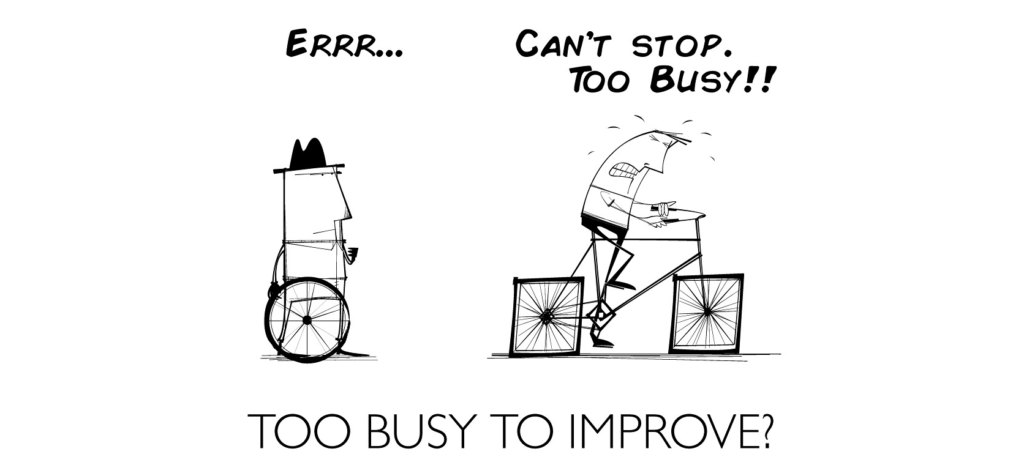
Are your productivity tools and habits propelling you toward success, or are you defaulting to mediocrity?
How much deliberate effort have you put into selecting the tools and developing the habits that determine the quality and outcomes of your life?
Do you have success support systems, and are they optimized?
In Atomic Habits, James Clear popularized a retooled version of Archilochus’ almost 3,000-year-old observation, which is:
“You do not rise to the level of your goals, you fall to the level of your systems.”
Clear also correctly observed that:
“Goals are good for setting a direction, but systems are best for making progress.”
As we approach the New Year, billions of people will customarily set goals for themselves that they will invariably give up on shortly thereafter, as they do.
They will do this for a number of reasons, but primarily because simply having a goal does not create a path or method to achieve success, systems do. And whether you have deliberately developed your systems or not, you do have systems that you rely upon (even if your default system is not to have a system). It’s very likely that if you haven’t thoughtfully developed your systems, they are at best unreliable and inefficient, and at worst, they’re silently and violently sabotaging you.
Have you ever tried to swim with your clothes on?
No?
I had to do this a few times for the U.S. Army and German Bundeswehr. It’s surprisingly harder than it looks.
Perhaps you’ve tried to walk or run with wet, muddy, boots on? Both of these scenarios are at best, mildly inefficient.
Such is life when you try to tackle it without intentionally designed success support systems. You might as well be trying to swim across the English Channel in a tuxedo and hiking boots.
So then, if the capabilities and shortcomings of our systems impact our success in life in such a tangible and meaningful way, wouldn’t it make sense for us to take a moment to optimize those systems, such that in so doing, we optimize for success in life?
Think about those wet, muddy, boots again. Let’s suspend reality for a second and say that you were running a marathon in these same boots. Let’s also suppose that, in this alternate reality, there was a kind old man giving away high-performance racing shoes to anyone who would stop and accept them.
Would you stop and take the two or three minutes necessary to change your shoes, vastly improve your run time (and your personal comfort), or would you keep on running?
It is pretty safe to assume that every one of us would stop. The time spent replacing the water-logged boots with featherweight racing sneaks would be almost inconsequential in comparison to the time saved, and painful blisters avoided, running the marathon in optimized running gear. And just as assuredly as wet, muddy, hiking boots would kill our run time over the 26.2 miles of a marathon, so too is the drag of poorly designed (or non-existent) success support systems amplified over the longest race of all, our life.
So when was the last time you stopped to shed the muddy boots? Or have you, ever?
How do we shed these metaphorical muddy boots and upgrade our success support systems in the marathon race of life?
It starts with a time out—simply stopping to take a look at what’s on our feet. Although it sounds easy, this is often the hardest part, especially when life is moving so fast. Not to mention, while we’re stopped the pressure of the crowd running by can be almost unbearable in the moment.
It’s a little like…

But regardless of your perceived busyness levels, when was the last time that you took a time out to evaluate your current tools and habits to determine if those systems are serving you best?
To be clear, I didn’t ask if they were serving you good enough. I asked, when was the last time you evaluated your systems to determine if they are serving you best?
It’s very likely that good enough has gotten you to your current run of successes in life, which may also be, “just fine,” but have you ever stopped to imagine how much better things could be if your success support systems were fully optimized?
That is, what if, instead of systems that simply keep you just short of the brink of chaos or catastrophe (i.e. out of the yellow or red), you had systems that keep you in the green, at or well below your maximum threshold? And what if this could be the new status quo?
In the display below, we see a scenario where a pilot has almost run out of power (torque, or “Q”) on the number one engine. Pilots generally do whatever is necessary to keep things “in the green”. This provides a margin of safety, or a buffer, so that if for some reason additional transient power is needed, it’s there.
What if you had systems that provided you with a similar buffer? A buffer that not only provides you transient, surge, or additional bandwidth when needed, but one that allows you to leave work on time, pursue a hobby, or actually play with your kids when you get home? Systems that benefit you, systems in service of your best life?
At some point, I will dedicate the commensurate word count to explaining how we build a buffer into our systems such that we do not live on transient power (in the yellow and red zones), but that is not our current focus.
Hopefully, at this point, the value of taking a breath to take stock of our systems and how we’ve organized ourselves for combat—or work and life (sometimes the differences can seem minor) is abundantly clear.
Assuming so, let’s take a brief look at the success support systems everyone must have to be successful in the digital age.
There’s only three, and they’re quite simple:
📅 Time Management System – A habit-driven calendar app.
📋 Task Management System – A habit-driven to-do app.
📂 Knowledge Management System – A place to store information and generate ideas.
Each of the three systems above are just ordinary tools (i.e. calendar, to-do, or file storage apps). However, when we deliberately determine when, why, and how we will interact with these tools by establishing habits and routines, they become systems. Most importantly, when we do this consistently (i.e. without fail) they become trusted systems.
The formula is pretty straightforward: Trusted Systems = Tools + Habits
An entire discussion could also be had about tools, habits, routines, and trusted systems, but once again, not the focus of this piece.
Here are the components of an optimized success support system:
- A calendar app supported by habits or routines to make it reliable.
- A to-do app supported by habits or routines to make it reliable.
- A digital storage app supported by habits or routines to make it reliable.
So how do we optimize these systems to optimize our success in the marathon of life?
We do it by asking some simple questions.
As Mr. Anthony Robbins so eloquently put it:
“The quality of the questions that you ask yourself directly determine the quality of your life.”
So as you seek to identify, upgrade, and optimize the tools, habits, and routines that support your individual needs in the way that you uniquely function, consider the following success support system evaluation questions:
- Does this tool or system serve me best? Does it provide the results I need, in the most efficient and effective manner
- Is it frictionless? Your tools should minimize delays, clicks, or swipes and they should be a joy to use (shortcuts and voice commands ftw).
- Is it lightweight? Your tools/systems should serve you effortlessly and should require minimal upkeep for them to produce the desired results.
- Is it reliable? Would you bet your life on your system?
If the answer is no to any of these questions, the next step is to stop and think. Think about what would make each of these answers a yes. If you’re not sure, reach out, maybe I can help.
Once you’ve determined what turns each of these into yes answers, take action:
- Identify the tools necessary to most effectively serve future you.
- Optimize your habits and routines to turn those tools into trusted systems.
- Rinse and repeat.
Above all else, when you catch yourself running in hiking boots, do not hesitate to pull over and change shoes. The future, and most successful you, will thank you for it!
—
Want more insights? Sign up for my newsletter, or check out my related TikTok or Instagram posts where I demystify how to be successful in today’s digital world.
Also published on Medium.